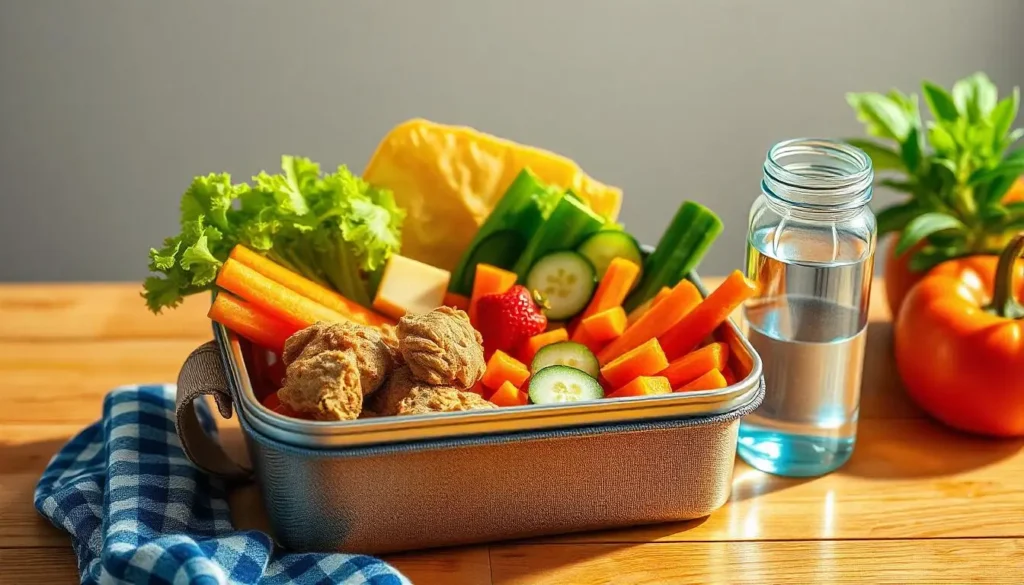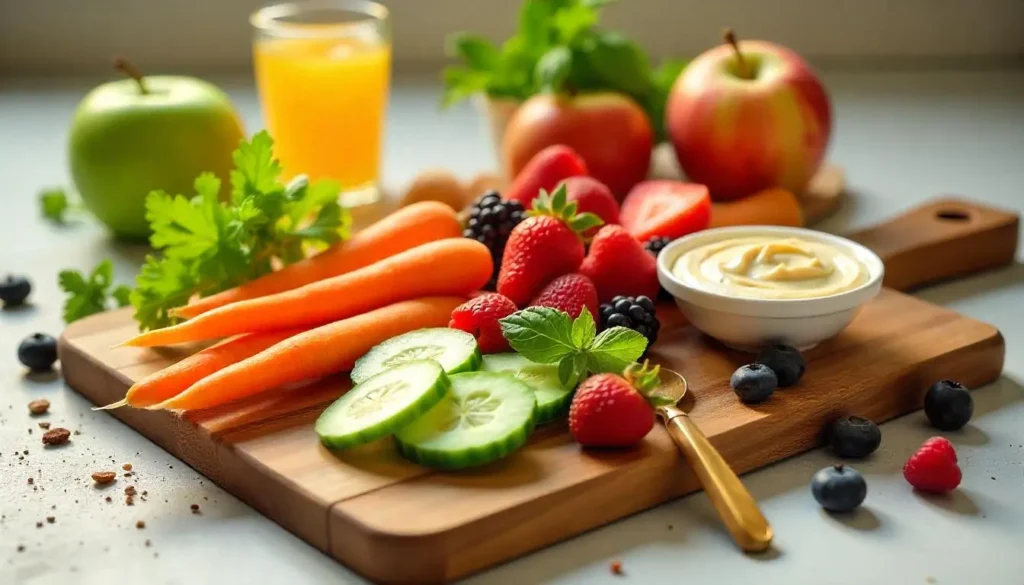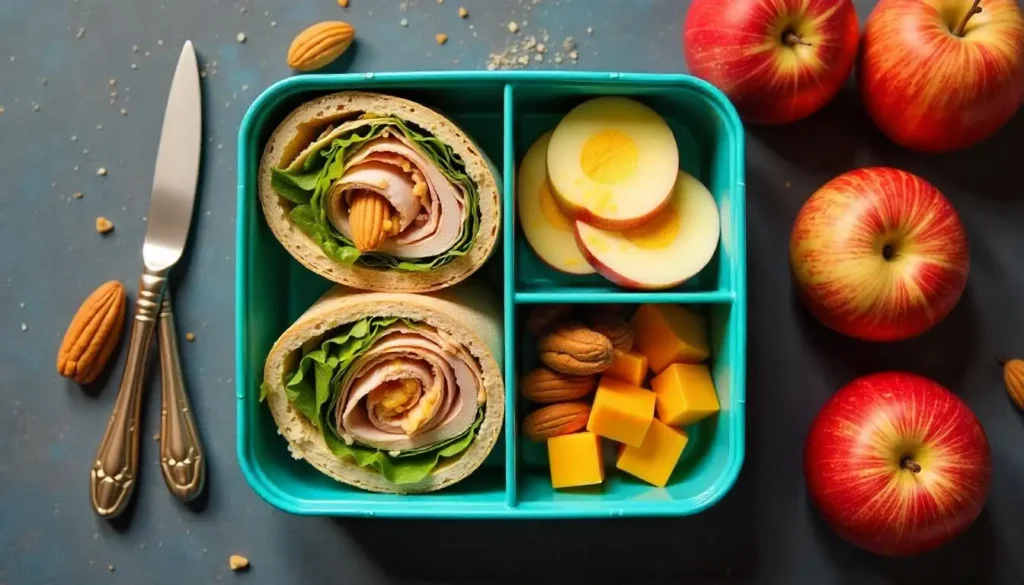Managing ADHD symptoms is no easy feat, especially when it comes to maintaining focus and energy throughout the day. What if the key to better concentration and reduced hyperactivity lay in what’s packed for lunch? Crafting an ideal lunch for ADHD involves combining balanced nutrition, practical tips, and tasty options to create meals that support better focus and behavior. This article dives into how the right foods can make all the difference. Let’s explore how to build the perfect midday meal for individuals with ADHD.

Understanding the Connection Between Nutrition and An Ideal Lunch for ADHD
A well-balanced diet can have a profound impact on managing ADHD symptoms. The brain relies on a steady supply of nutrients to function optimally, and for individuals with ADHD, dietary choices can either enhance focus or exacerbate challenges.
The Role of Diet in Preparing An Ideal Lunch for ADHD
Research consistently shows that food influences behavior and cognitive function. Certain nutrients fuel the brain, improving alertness and reducing hyperactivity. On the flip side, sugary or processed foods can lead to energy crashes and increased impulsivity. Understanding this link is the first step toward preparing an ideal lunch for ADHD.
Addressing Nutritional Deficiencies for ADHD-Friendly Meals
Children with ADHD often exhibit deficiencies in key nutrients like iron, zinc, and omega-3 fatty acids. These deficiencies may worsen inattentiveness and hyperactivity. Addressing these gaps through lunch foods rich in protein, healthy fats, and vitamins can have a noticeable impact on behavior and mood.
Why An Ideal Lunch for ADHD Matters for Symptom Management
Lunch plays a crucial role in sustaining energy and focus throughout the afternoon. With schoolwork, extracurricular activities, or professional responsibilities, the wrong choice of lunch can spell disaster for concentration. A thoughtfully curated lunch minimizes blood sugar spikes, ensuring steady energy levels and mental clarity.
Core Principles of Crafting an Ideal Lunch for ADHD

Crafting an ideal lunch for ADHD starts with understanding key principles that support focus, energy, and overall well-being. These guidelines ensure meals are not only nutritious but also practical and enjoyable for children or adults managing ADHD.
Avoiding Common Triggers in an ADHD-Friendly Lunch: Artificial Dyes, Sugar, and Gluten
Certain ingredients, like artificial dyes and added sugars, are known to exacerbate hyperactivity and inattentiveness. Foods like candy, sugary drinks, and processed snacks can cause blood sugar spikes followed by crashes, leaving kids feeling sluggish and unfocused. Similarly, gluten sensitivity in some individuals with ADHD may worsen symptoms, making gluten-free options worth considering.
Instead, focus on natural, whole foods. Think fresh fruits, vegetables, and minimally processed proteins. Replacing sugary snacks with options like apple slices or nuts not only prevents sugar highs and lows but also helps sustain energy throughout the afternoon.
Incorporating Protein and Healthy Fats for an Ideal Lunch for ADHD
Protein is a powerhouse nutrient for an ideal lunch for ADHD. It fuels the brain, promotes alertness, and stabilizes energy levels. Foods like eggs, lean meats, nut butters, or Greek yogurt are excellent choices. Healthy fats, found in avocados, nuts, and seeds, are equally important for cognitive function, providing long-lasting energy and supporting overall brain health.
Pairing protein with healthy fats ensures sustained focus and a feeling of fullness, reducing the likelihood of hunger-induced irritability later in the day.
The Importance of Routine and Predictability in ADHD-Friendly Meals
For many individuals with ADHD, predictability in meals can reduce stress and anxiety. Repeating favorite foods in lunches creates a sense of comfort and familiarity. While variety is important over time, sticking to a reliable rotation of meals—like a protein-packed sandwich or veggie sticks with hummus—makes lunch preparation easier and keeps mealtime stress-free.
Designing the Perfect Lunchbox for ADHD
Once you understand the principles behind an ideal lunch for ADHD, it’s time to put them into action. Designing a lunchbox that’s both nutritious and appealing ensures kids (or adults) are more likely to enjoy their meals and reap the benefits.
Essential Components of an ADHD-Friendly Lunchbox: Protein, Veggies, and Hydration
Every ADHD-friendly lunchbox should start with a high-protein item. Whether it’s grilled chicken, a turkey wrap, or a handful of nuts, protein provides the energy and focus needed to tackle the rest of the day. Veggies, like carrots, cucumbers, and bell peppers, offer fiber and essential vitamins, supporting overall health and digestion.
Hydration is equally vital. Dehydration can cause brain fog and lower energy levels, so including a reusable water bottle ensures easy access to water throughout the day. Steer clear of sugary drinks; instead, encourage plain water or infused options with lemon or cucumber for flavor.
Convenience and Nutrition in ADHD-Friendly Lunches: Balancing Healthy and Easy Options
Parents often face the challenge of balancing health with convenience, especially during hectic mornings. Including prepackaged but nutritious items, like hummus cups, guacamole packs, or protein bars, can save time without compromising on quality.
Foods like pre-sliced fruits, cheese sticks, or whole-grain crackers are great add-ons that require minimal preparation. These options not only make packing easier but also help ensure the lunchbox is appealing to children and meets the nutritional goals of an ideal lunch for ADHD.
The Role of Presentation in Encouraging ADHD-Friendly Eating Habits
Presentation matters, especially for children who may feel self-conscious about their lunches. Ensuring the meal looks similar to peers’ lunches can help alleviate social anxiety. This might mean including one “normal” packaged item, like a granola bar, alongside healthier options.
Additionally, using fun containers or colorful wraps can make the meal more inviting. Bento boxes, for instance, allow foods to stay separated and visually appealing, which can be especially helpful for picky eaters.
Top ADHD-Friendly Lunch Ideas

Creating an ideal lunch for ADHD doesn’t have to be a daunting task. With a mix of simplicity and nutrition, you can craft meals that cater to both taste and focus. Here are some practical and delicious ideas.
Quick Protein-Packed Meals
Protein is the star of any ADHD-friendly lunch, as it promotes alertness and sustains energy. Easy-to-prepare options include grilled chicken wraps, turkey and cheese roll-ups, or hard-boiled eggs paired with a handful of nuts. For something warm, consider this high-protein lunch recipe from Fest Recipes: Chicken Sausage Pasta, which is both hearty and ADHD-friendly.
For those who prefer vegetarian choices, chickpea salad or quinoa bowls with roasted veggies and feta cheese offer protein and flavor. Adding a dollop of hummus on the side boosts both taste and nutrition.
Low-Sugar Snacks and Desserts
Kids and adults alike love snacks, but it’s crucial to avoid sugar spikes. Instead, opt for low-sugar options like apple slices with almond butter, unsweetened yogurt topped with berries, or homemade granola bars using oats and dried fruits.
If you’re looking for more inspiration, check out Creative Healthy Toddler Lunch Ideas for snack pairings that work well for all ages.
Vegetables and Fruits: Easy and Enjoyable Options
Fresh produce adds color, crunch, and essential nutrients. Pre-sliced carrots, cucumber sticks, or cherry tomatoes paired with ranch dressing or hummus make veggies appealing. For fruits, choose firm and portable options like apple slices, orange segments, or grapes. Avoid mushy fruits like bananas, which may not hold up well in lunchboxes.
To keep things fresh and exciting, experiment with creative presentations like fruit skewers or veggie-packed wraps.
Overcoming Challenges in ADHD Lunch Planning
Even the most thoughtfully planned lunches can encounter roadblocks. From picky eaters to tight budgets, addressing these challenges ensures you stay on track when preparing an ideal lunch for ADHD.
Addressing Picky Eating Habits
Picky eating is a common hurdle, but it can be managed by including a mix of familiar and new foods. Start small by introducing new ingredients alongside favorites. For example, serve hummus with their preferred crackers before pairing it with veggie sticks.
Allowing children to participate in lunch preparation, like assembling wraps or choosing fruits, increases their interest in eating what’s packed.
Managing Budget for Healthy Choices
Eating healthy can feel expensive, but smart planning makes it manageable. Buying produce in bulk, opting for frozen vegetables, and utilizing sales can cut costs. Prepackaged items, while convenient, can be pricier, so consider preparing snacks like granola bars or energy balls at home.
For meal inspiration, visit Gluten-Free Lunch Ideas to explore affordable and nutritious options.
Ensuring Compliance with School Guidelines
Many schools have restrictions on allergens, like peanuts, making it essential to pack alternatives. Swap peanut butter for sunflower seed butter or almond butter, and check labels on prepackaged snacks for hidden allergens.
Labeling items in the lunchbox ensures clear communication about what’s included, especially in shared lunch environments.
FAQs About ADHD and Diet, Lifestyle, and Well-Being
Here are some additional frequently asked questions about ADHD, covering dietary preferences, recommended foods, lifestyle tips, and happiness boosters.
What Do ADHD People Like to Eat?
Individuals with ADHD often enjoy flavorful, easy-to-eat foods that don’t feel overly restrictive. Finger foods like nuts, fruits, cheese cubes, or veggie sticks paired with dips are common favorites. They also appreciate meals that are simple yet satisfying, such as sandwiches, wraps, or pasta with mild sauces.
The key is to provide foods that balance taste and nutrition. Protein-rich options like chicken, eggs, or peanut butter, combined with fresh produce, are excellent choices for creating an ideal lunch for ADHD.
What to Feed Someone With ADHD?
When feeding someone with ADHD, focus on meals rich in protein, healthy fats, and complex carbs. These nutrients stabilize blood sugar levels and fuel the brain for sustained focus and energy. Some great options include:
- Grilled chicken wraps with whole-grain tortillas
- Greek yogurt topped with nuts and berries
- Quinoa salad with roasted vegetables
- Apples or carrots with almond butter
Avoid processed foods, artificial additives, and high-sugar snacks, as these can exacerbate hyperactivity and inattentiveness.
What Is the Best Lifestyle for Someone With ADHD?
A healthy lifestyle for someone with ADHD combines structured routines, physical activity, and a balanced diet. Regular exercise helps reduce hyperactivity and improve focus by increasing dopamine and serotonin levels. Sleep hygiene is equally important, as lack of rest can intensify ADHD symptoms.
Pairing these habits with mindfulness techniques, such as meditation or deep breathing, can improve self-regulation. Having consistent schedules for meals, activities, and relaxation promotes a sense of stability.
What Makes a Person With ADHD Happy?
People with ADHD thrive in environments that foster creativity, novelty, and positive reinforcement. Activities that allow for hands-on learning, exploration, or physical movement often bring joy. Engaging in hobbies like art, sports, or music can boost mood and confidence.
Strong, supportive relationships also play a big role in happiness. Encouraging communication, offering understanding, and celebrating small wins can go a long way. Providing meals that cater to their preferences while supporting their health—like an ideal lunch for ADHD—can also contribute to overall well-being.
Conclusion and Final Tips for an Ideal ADHD-Friendly Lunch
Preparing an ideal lunch for ADHD might seem overwhelming at first, but with the right approach, it becomes a rewarding part of daily life. From understanding the critical role of protein and hydration to navigating challenges like picky eaters and school restrictions, each step supports better focus and behavior.
Final Tips for Success
- Plan Ahead: Prepping ingredients and packing lunchboxes the night before saves time and reduces stress in the morning.
- Involve Your Child: Let them pick their favorite healthy snacks or assemble their own wraps to make meals more enjoyable.
- Keep It Balanced: Aim for a mix of protein, healthy fats, and fiber-rich carbs in every lunchbox.
- Monitor and Adjust: Pay attention to how certain foods affect your child’s focus and energy, and tweak meals accordingly.
For more practical ideas and meal inspiration, check out High Protein Lunch Ideas. With a little creativity and planning, you can craft meals that are as nutritious as they are delicious. By prioritizing these principles, you’ll set the stage for your child’s success, both inside and outside the classroom.
